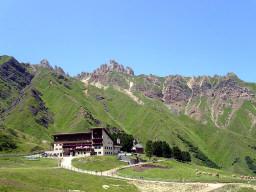Local officials behind a bid to include the Dolomite mountain range in UNESCO's World Heritage List believe the United Nations' cultural and natural heritage body will be favourably impressed by conservation practices in Italy's northern regions.
The request the World Heritage Committee will consider in June includes nine mountain groups spanning three of Italy's northern regions: Veneto, Friuli-Venezia Giulia and Trentino Alto Adige.
The principal factors that led the Italian state to nominate the Dolomites as a World Heritage Site are the unique evidence of geological processes and their exceptional natural beauty.
The first application in December 2004 included twenty-two groups of mountains and was based on four of the permitted World Heritage criteria for natural sites: exceptional natural beauty, significant ongoing geological processes, significant ongoing ecological and biological processes, and significant natural habitats for conservation of biological diversity.
After an investigation in 2006 by the World Heritage Committee's technical advisory body on natural heritage - the International Union for the Conservation of Nature (IUCN)- the number of mountain groups was reduced to nine and the criteria were narrowed to natural beauty and geological processes.
Earlier this month the IUCN endorsed the second version of the bid and the World Heritage Committee's final verdict is expected by the end of June.
Local officials say a positive outcome will be a reward for their conservation policies.
''It would be a confirmation of how this heritage has been conserved'', said Markus Maurmair, provincial councillor for the Friuli province of Pordenone tasked with territorial planning, European policies, agriculture and tourism.
''Additionally, if you take into account that Italy has the most World Heritage cultural sites but only one natural site so far, the recognition means even more'', observed the councillor.
''I believe the nomination may also be a challenge for the United Nations organisation as well, because it is the first time a serial site is being considered, an area spanning five provinces in the three regions.
It was a new experience for the IUCN and the process may be useful for other sites with similar characteristics,''he said.
Praising his province's conservation policies, Maurmair cites the environmental protection measures instituted in the Friuli Dolomites Regional Park - which encompasses one of the nine mountain groups in Italy's application.
The Val Montanaia, with its famous 300-metre Bell Tower, is the park's most well-known alpine area.
The IUCN visits made after Italy's first application found all four World Heritage criteria for natural sites in the Pordenone province's Dolomites, including ongoing ecological and biological processes and natural habitats for the conservation of biological diversity.
Local authorities say this is proof the Friuli mountains are an undamaged haven and still largely unaltered by human use or tourism.
Dolomites-Unesco: friuli, nomination process useful challenge
